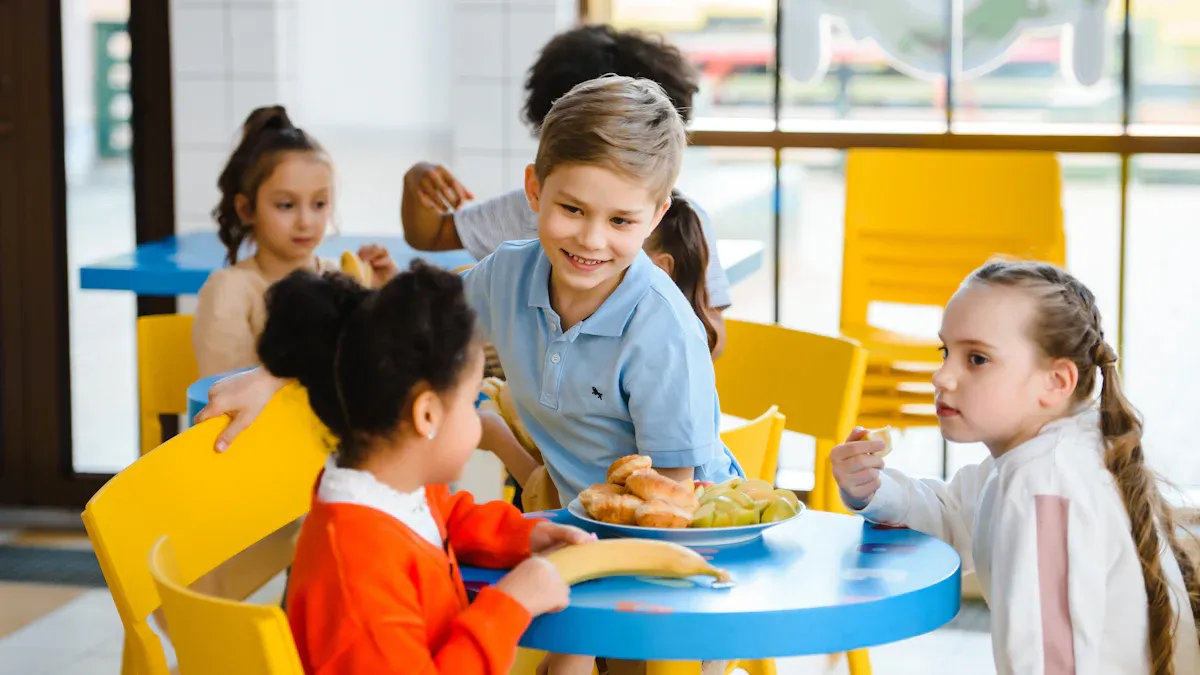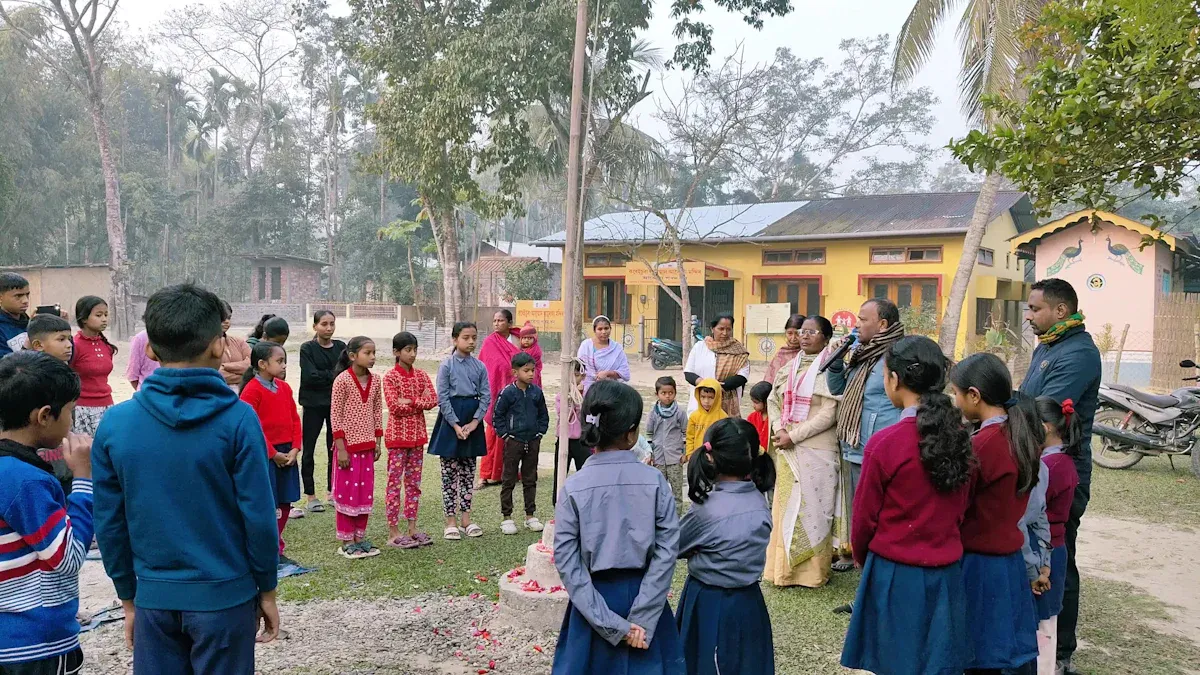Building Strong School-Community Connections for Youth Education

Imagine a world where every student has the tools to thrive, both in and out of the classroom. School-community partnerships hold the power to make this vision a reality. When schools and communities work together, they create opportunities that transform lives. These partnerships address challenges like limited resources and unmet student needs. For example, in 2010 alone, partners contributed over $230 million to support educational initiatives. Over the past five years, more than $1 billion has been invested in 21st Century Community Learning Centers.
You can play a vital role in collaborating with schools for youth education. Together, we can build a brighter future for every child.
Key Takeaways
Schools and communities working together help students do better in school.
Involving local groups and families builds support and makes students feel included.
Good communication and clear tasks for everyone are key to teamwork.
Sharing wins and telling success stories encourage more people to join in.
Begin with small steps by finding common goals and using local help.
Collaborating with Schools for Youth Education

What Are School-Community Partnerships?
Defining the concept and scope
School-community partnerships are collaborative efforts between schools and local organizations, businesses, families, and other stakeholders. These partnerships aim to address the diverse needs of students by pooling resources, expertise, and support systems. They go beyond academics, focusing on the holistic development of students. For example, comprehensive school-site partnerships leverage existing resources to improve academic outcomes, attendance, and overall development.
The scope of these partnerships varies widely. Some focus on providing mentorship programs, while others offer wraparound services like health care, counseling, and extracurricular activities. The Community Engagement Continuum highlights how these collaborations can range from minimal involvement to full-service partnerships, emphasizing the importance of shared goals and active participation.
Key characteristics of effective partnerships
Effective school-community partnerships share several key traits. First, they establish clear roles and responsibilities for all stakeholders. This ensures that everyone understands their contribution to the shared mission. Second, they foster open communication, creating an environment where ideas and concerns can be freely exchanged. Third, they develop shared norms and expectations, which help maintain consistency and trust among partners. Finally, successful partnerships prioritize continuous improvement, regularly assessing their impact and making necessary adjustments.
Evidence Type | Description |
|---|---|
Comprehensive School-Site Partnerships | Leverage resources to support the whole child, improving academic and developmental outcomes. |
Community Engagement Continuum | Emphasizes varying levels of collaboration between schools and communities. |
Implementation Strategies | Require shared norms, clear roles, and communication processes for success. |
Why Are These Partnerships Essential?
Addressing academic challenges
Collaborating with schools for youth education helps tackle academic challenges head-on. Partnerships provide access to diverse learning resources, such as tutoring programs, technology, and specialized workshops. Research shows that these collaborations improve academic outcomes, attendance, and on-time grade progression. By aligning educational goals and curricula, schools and communities create a cohesive learning environment that benefits students.
Supporting non-academic needs
Students often face barriers outside the classroom that hinder their success. School-community partnerships address these challenges by offering services like mental health counseling, nutrition programs, and after-school activities. These initiatives ensure that students feel supported in every aspect of their lives, enabling them to focus on their education.
Building a stronger support network for students
A robust support network is crucial for student success. Partnerships strengthen this network by involving families, local organizations, and community leaders. Studies highlight the importance of human interaction in fostering trust and resilience among youth. When students see their community actively engaged in their education, they feel a greater sense of belonging and motivation to succeed.
School-community partnerships enhance program quality and resource efficiency.
These collaborations lead to better alignment of educational goals and curricula.
Comprehensive partnerships improve attendance and academic outcomes.
The Benefits of School-Community Partnerships

Academic Growth
Improved student performance and engagement
School-community partnerships create an environment where students can excel academically. By integrating resources like tutoring programs, afterschool services, and technology, these collaborations directly enhance student performance. For instance, schools that engage parents and foster supportive environments report better academic outcomes. Partnerships like PASA have improved afterschool services, benefiting over 360 youth and expanding academic opportunities. These efforts not only boost grades but also increase student engagement, making learning more enjoyable and meaningful.
Access to diverse learning resources
When schools and communities unite, students gain access to a wealth of learning resources. Community schools, for example, provide tools like specialized workshops, mentorship programs, and extracurricular activities. Research highlights that integrated partnerships improve attendance and on-time grade progression. By pooling local expertise and resources, these collaborations ensure that every student has the tools they need to succeed.
Social and Emotional Development
Mentorship and counseling opportunities
Strong partnerships offer students access to mentorship and counseling, which are essential for their social and emotional well-being. Programs focusing on social and emotional learning (SEL) have shown remarkable results. Studies reveal that students in SEL programs experience improved academic achievement, enhanced social skills, and reduced anxiety. These initiatives equip students with the resilience and confidence needed to navigate challenges both inside and outside the classroom.
Fostering a sense of belonging and community
When communities actively participate in education, students feel a stronger sense of belonging. This connection fosters trust and resilience, as highlighted by research from Darling-Hammond et al. (2020). A supportive school-community environment helps students build meaningful relationships, creating a positive school climate. This sense of belonging motivates students to engage more deeply in their education and personal growth.
Resource Optimization
Leveraging local expertise and funding
Effective partnerships optimize resources by leveraging local expertise and funding. Administrators use detailed student data to allocate resources where they are needed most. For example, over $1 billion has been invested in community learning centers over the past five years, addressing gaps in student achievement and well-being. These partnerships ensure that every dollar and effort is used to maximize impact.
Expanding extracurricular and enrichment programs
Collaborations with local organizations and businesses expand opportunities for students beyond the classroom. Enrichment programs in arts, sports, and STEM fields provide students with valuable experiences that enhance their skills and interests. Community schools, in particular, have demonstrated success in improving academic performance while increasing family involvement and community engagement. These programs not only enrich students' lives but also prepare them for future success.
Did you know? Hundreds of studies confirm that school-community partnerships improve academic outcomes, attendance, and social-emotional development. By working together, schools and communities can create a brighter future for every student.
Strategies for Building and Sustaining Partnerships
Leveraging Community Assets
Identifying and engaging local organizations and businesses
To build strong school-community partnerships, you can start by identifying local organizations and businesses that align with your goals. These groups often have resources, expertise, or funding that can enhance educational outcomes. For example, during the pandemic, community-based partnerships created hubs for educational support, helping schools adapt to new challenges. Models like StriveTogether demonstrate how leveraging local assets can improve student success. Partnerships like the one between the United Way and Cleveland Metropolitan School District show how collaboration expands learning opportunities and strengthens community ties.
Involving families and community leaders
Families and community leaders play a vital role in creating sustainable partnerships. By involving them, you ensure that the initiatives address real needs and reflect shared values. Engaging these stakeholders fosters trust and builds a sense of ownership. The partnership between Roger Williams School and the Providence After School Alliance highlights how involving families and local leaders can improve afterschool services and positively impact hundreds of students.
Implementing Wraparound Services
Coordinating academic and non-academic support
Wraparound services integrate academic and non-academic support to meet students' diverse needs. These services bring essential resources like health care, counseling, and after-school programs directly into schools. Site coordinators help connect schools with community providers, creating a seamless support system. Comprehensive school-site partnerships, such as full-service community schools, have proven effective in leveraging existing resources to support students holistically.
Did you know? Integrated student supports have shown meaningful success in addressing both academic and non-academic challenges, ensuring students thrive in all aspects of their lives.
Addressing barriers to student success
Barriers like mental health issues, food insecurity, or lack of access to extracurricular activities can hinder student success. Wraparound services address these challenges by providing targeted support. By coordinating with local organizations, you can ensure that students and families receive the help they need. This approach not only improves educational outcomes but also strengthens the community as a whole.
Fostering Open Communication
Establishing shared goals and expectations
Clear communication is the foundation of any successful partnership. Establishing shared goals and expectations ensures that everyone works toward the same vision. School leaders and teachers can initiate collaborative activities with families and community members to align efforts. Flexibility in communication frameworks also promotes resiliency, allowing partnerships to adapt and thrive over time.
Maintaining regular and transparent dialogue
Regular and transparent dialogue keeps partnerships strong. Ongoing collaborative activities help adjust policies to meet evolving needs. For example, school leaders reaching out to community organizations create a welcoming environment for partnership development. A commitment to open communication fosters trust and minimizes misunderstandings, ensuring long-term success.
Evidence | Explanation |
|---|---|
Ongoing collaborative activities are essential for effective partnerships. | Continuous communication ensures alignment and adaptability. |
Flexibility promotes resiliency in partnerships. | Adaptable frameworks help sustain partnerships over time. |
Initiating collaborative activities minimizes territorial friction. | Outreach by school leaders fosters a welcoming environment. |
Tip: Dedicate time and resources to building trust and maintaining open communication. These efforts will pay off in the form of stronger, more effective partnerships.
Celebrating Achievements
Recognizing contributions from all stakeholders
Every successful school-community partnership thrives on the dedication of its stakeholders. Recognizing their efforts strengthens relationships and motivates continued collaboration. You can start by celebrating the contributions of teachers, parents, local businesses, and volunteers. A simple thank-you note or a public acknowledgment during school events can go a long way.
Organize appreciation ceremonies or awards to honor those who make a difference. For example, you could create categories like "Outstanding Community Partner" or "Parent Champion of the Year." These recognitions not only show gratitude but also inspire others to get involved.
Tip: Use newsletters or social media to highlight the efforts of individuals and groups. A public shout-out can amplify their impact and encourage others to contribute.
Sharing success stories to inspire further collaboration
Success stories have the power to inspire and unite. Share the achievements of your partnership to showcase its positive impact. For instance, if a mentorship program helped students improve their grades, tell that story. Highlight the journey, the challenges overcome, and the results achieved.
You can use various platforms to share these stories. Create short videos, write blog posts, or host community events where students and families share their experiences. These stories remind everyone of the value of working together.
Example: A school partnered with a local art studio to offer free workshops. Students not only learned new skills but also gained confidence. Sharing this story encouraged other businesses to join the initiative.
Did you know? Sharing success stories builds momentum. It shows what’s possible when schools and communities unite for a common goal.
By celebrating achievements, you create a culture of appreciation and inspiration. This keeps the partnership strong and encourages others to join the mission of empowering youth education.
Common Challenges and How to Overcome Them
Misaligned Expectations
Creating a shared vision among partners
Misaligned expectations can create friction in school-community partnerships. When educators and community members come from different socioeconomic or cultural backgrounds, misunderstandings may arise. This disconnect can limit culturally relevant learning experiences, reducing student engagement and trust. To overcome this, you can focus on building a shared vision that aligns everyone’s goals.
Start by developing shared norms and expectations. Regular discussions about accomplishments and challenges help ensure everyone stays on the same page. For example, schools that involve all stakeholders in planning processes create a positive environment where collaboration thrives. By fostering open communication and mutual understanding, you can bridge gaps and create a partnership that benefits all students.
Clarifying roles and responsibilities
Unclear roles often lead to confusion and inefficiency. Defining responsibilities for each partner ensures that everyone knows their contribution to the shared mission. You can facilitate this by creating accessible communication channels where roles are clearly outlined. Schools that proactively invite community organizations into partnerships often avoid territorial conflicts over resources. This approach fosters a collaborative atmosphere, ensuring that every partner works toward the same goal.
Resource Limitations
Addressing funding and staffing challenges
Limited resources can hinder the success of school-community partnerships. However, many partnerships effectively utilize existing resources and funding already available to schools. For instance, the Full Service Community Schools Act encourages schools to maximize their resources to support students holistically. You can also explore creative solutions like engaging local businesses or applying for grants to address funding gaps.
Staffing challenges can be mitigated by involving volunteers or training community members to take on specific roles. By thinking outside the box, you can ensure that resource limitations don’t stand in the way of student success.
Ensuring long-term sustainability
Sustainability is key to maintaining impactful partnerships. Flexibility in how resources are used promotes resiliency, allowing partnerships to adapt to changing needs. Regularly assessing the effectiveness of initiatives ensures that resources are allocated efficiently. You can also build sustainability by fostering strong relationships with community stakeholders. When everyone feels invested in the partnership, they are more likely to contribute to its long-term success.
Communication Barriers
Preventing misunderstandings and missed opportunities
Communication barriers can derail even the most well-intentioned partnerships. Lack of shared norms or mismatched expectations between educators and partners often leads to missed opportunities. To prevent this, involve all stakeholders in discussions from the beginning. Establishing clear communication processes and feedback cycles ensures that everyone stays informed and aligned.
For example, schools that develop shared norms and expectations with community organizations create a foundation for effective collaboration. This approach minimizes misunderstandings and keeps the partnership moving forward.
Building trust through consistent communication
Trust is the cornerstone of any successful partnership. Consistent communication builds this trust and ensures that everyone feels valued. Regular meetings, updates, and collaborative activities help maintain transparency and strengthen relationships.
Communication Barriers | Proposed Methods to Overcome Challenges |
|---|---|
Lack of shared norms and expectations | Involve all constituents in collaboration discussions from the start |
Mismatch between expectations and capacity | Develop shared norms, communication processes, and feedback cycles |
Territorialism among organizations | Initiate collaborative activities with families and community members |
By prioritizing open dialogue, you can create a partnership that thrives on trust and mutual respect. This ensures that every student benefits from the collective efforts of schools and communities.
School-community partnerships hold the key to transforming youth education. By working together, you can address academic challenges, support non-academic needs, and create a nurturing environment for students. Research shows that community involvement boosts student engagement and resilience, helping them persevere toward their goals. Programs with strong school-community ties also improve homework completion, effort, and behavior, as seen in the Massachusetts Afterschool Research Study.
The benefits of these partnerships are undeniable. They enhance program quality, align educational goals, and foster a sense of belonging. Start by collaborating with schools for youth education. Engage local organizations, families, and leaders to build a shared vision. Every small step contributes to a brighter future for students.
You have the power to make a difference. Take the first step today and inspire others to join this mission. Together, we can create impactful partnerships that empower the next generation.
FAQ
What is the first step to building a school-community partnership?
Start by identifying shared goals between the school and community. Reach out to local organizations, families, and leaders to discuss how you can work together. Focus on creating a vision that benefits students and aligns with everyone’s strengths.
Tip: Begin small. Even a single collaboration can spark meaningful change.
How can families get involved in these partnerships?
Families can participate by volunteering, attending school events, or joining planning committees. Their insights help shape programs that address real needs. Engaged families create a stronger support system for students and foster a sense of belonging.
Did you know? Students with involved families perform better academically and socially.
What if my community lacks resources for partnerships?
You can start by leveraging existing assets like local expertise or volunteers. Apply for grants or seek support from businesses. Many successful partnerships began with creative solutions and minimal funding.
Example: A small town partnered with a local library to provide free tutoring sessions.
How do partnerships benefit students beyond academics?
Partnerships address non-academic needs like mental health, nutrition, and extracurricular activities. These services help students feel supported and motivated. A well-rounded approach ensures they thrive both in and out of the classroom.
Emoji Inspiration: 🌟 Holistic support = Happy, healthy students!
How can schools and communities sustain long-term partnerships?
Sustainability comes from trust, regular communication, and shared goals. Celebrate achievements to keep everyone motivated. Assess the partnership’s impact and adapt as needed. Strong relationships ensure the collaboration remains impactful over time.
Key to Sustainability | Action |
|---|---|
Trust | Build through open dialogue |
Communication | Maintain regular updates |
Adaptability | Adjust to evolving needs |
Note: Long-term success depends on everyone’s commitment to the shared mission.
See Also
Join Us at Banish Cancer for Hope and Resilience
A Simple Guide to B-Cell Prolymphocytic Leukemia
Exploring Malignant Fibrous Histiocytoma and Osteosarcoma
